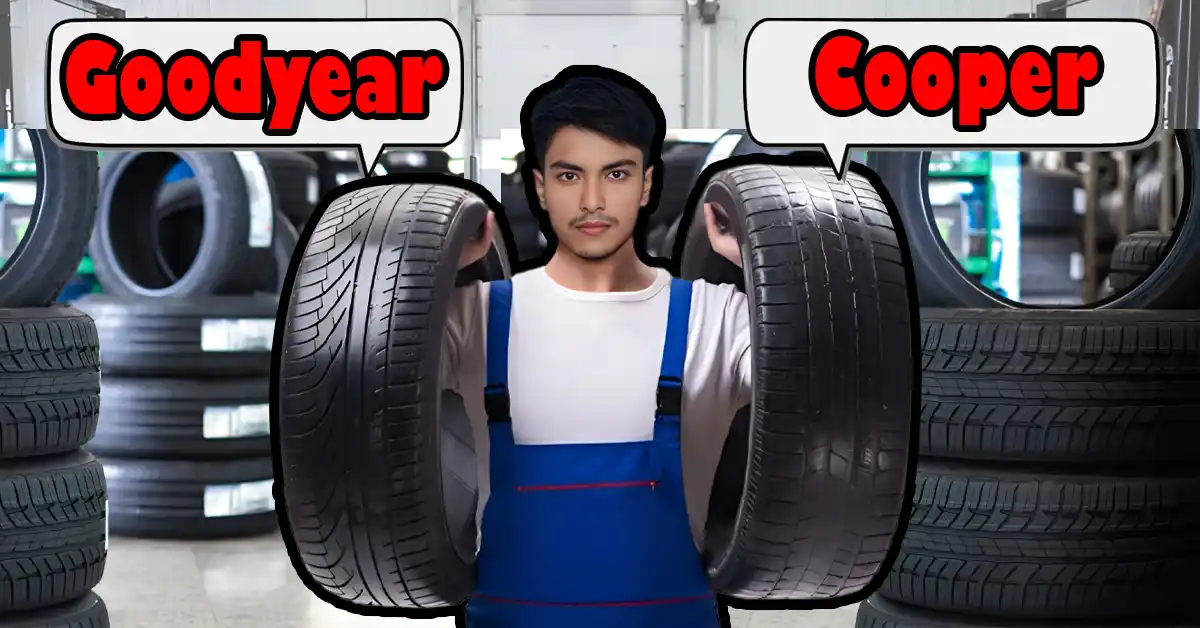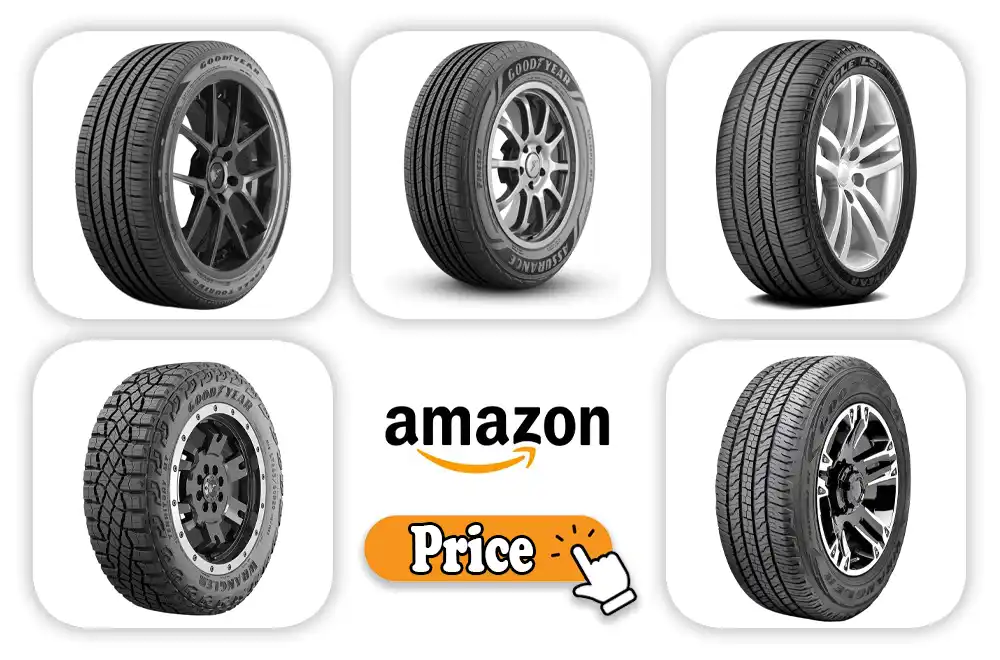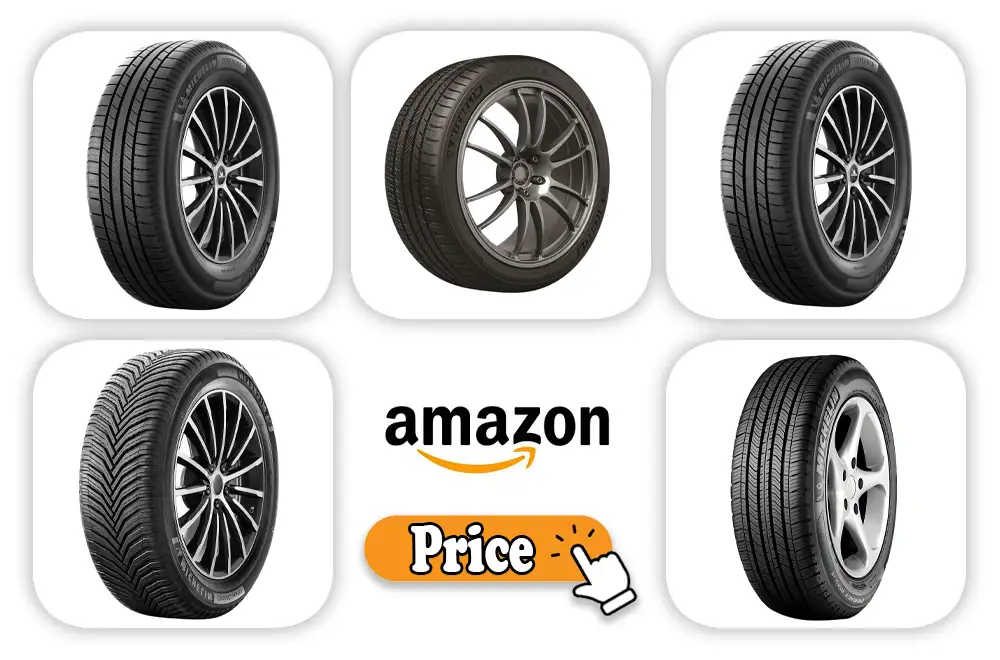Your tires do more than just roll. They affect how safe, smooth, and fuel-efficient your ride is. After years on U.S. roads—in rain, snow, and heat—I’ve seen how much tire brands matter.
No matter what you drive—a Ford F-150, Honda Civic, or Toyota RAV4—your tire choice can change your whole drive.
I’ve tested Goodyear and Michelin on highways, in city traffic, and on back roads. In this guide, I’ll show you how they really perform—so you can pick the right tire for your car, your budget, and your roads.
Table of Contents
Goodyear Tire Review: Real-World Performance From a Lifelong Driver
If you’re asking, “Are Goodyear tires worth it?” — let me answer fast. After 9+ years on the road, through Midwest winters and Texas heat, I can say: yes, they are. Goodyear gives a great mix of grip, comfort, and durability. Whether you drive every day, take weekend trips, or want value for your money, Goodyear likely has a tire for you.
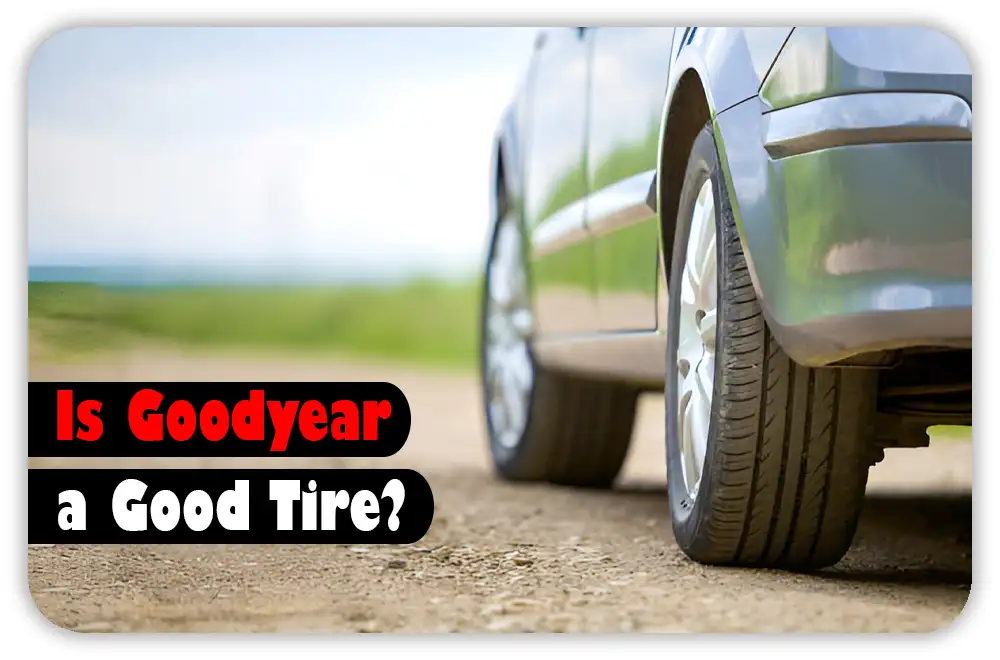
I’ve driven through 45 states and over 600,000 miles. I’ve tested more tire brands than I can count. From flying down the freeway in a Mustang GT to hauling a camper through the Rockies in a Silverado, tires have always mattered to me. Why? Because your tires are the only thing touching the road.
Real-World Performance: My Experience with Goodyear Tires
Cold Weather & Snow: I’ve lived in Ohio most of my life. Winters here are no joke. I’ve trusted Goodyear tires for icy roads and snowy mornings. The Assurance WeatherReady and Ultra Grip Ice WRT tires have been solid. I’ve taken them on I-75 during whiteouts and felt safe. They grip well, even when stopping on slush. Both are rated with the 3PMSF snowflake badge, and they’ve earned it.
Long-Distance & Highway Driving: I drive long trips, like Cleveland to Nashville. My Eagle Sport All-Season tires were smooth and steady. They made the ride quieter — even on rough pavement. I also saw a 2 MPG boost on the highway versus my old stock Continentals. The sidewalls feel firm and stable at high speeds. These tires love dry roads.
Stop-and-Go Traffic & City Driving: For city driving, I used the Assurance ComfortDrive. I felt in control, even on wet streets or potholes. In Detroit or Tampa rainstorms, they gripped well. Stopping felt faster and turning felt sharp. Compared to my old Firestones, these were a big step up.
Key Technical Aspects of Goodyear Tires
- Tread Grip: Goodyear tires use smart tread designs. Many use an asymmetric pattern that helps with grip in wet and dry weather. My Eagle F1s corner well and rarely hydroplane.
- Tread Life: These tires last. My Assurance MaxLife set ran over 85,000 miles before the grip dropped. Many touring models have a treadwear rating over 700.
- Comfort: Even on bumpy roads, Goodyear tires stay quiet. The ComfortDrive uses ComfortFlex tech, which smooths the ride without making it too soft.
- Weather Ratings: Most of their all-season and winter tires are M+S rated. Some, like the WeatherReady, also have the 3PMSF badge for winter use.
What I Like About Goodyear Tires
- Great traction and control: Dry, wet, or snowy — they grip well. Their winter grip rivals some snow-only tires I’ve used.
- Long-lasting tread: Many of my sets lasted 70,000+ miles. With rotations and care, they really hold up.
- Smooth, quiet ride: Especially touring tires. They soak up bumps and keep cabin noise low.
- Better gas mileage: Goodyear tires reduce drag. I saw a 5% MPG gain with the Assurance Fuel Max.
- Good for most U.S. drivers: They cover all needs — commuting, road trips, or daily errands.
What Could Be Better
- A bit pricey: Goodyear tires cost more than brands like General or Cooper. But the quality shows.
- Not a full winter tire: Their all-seasons do fine in light snow, but if you live in places like Minnesota, get a true snow tire.
- Not always in stock: Some models, like the Eagle F1 Asymmetric 3, I had to buy online. Local stores didn’t carry them.
- Some sport tires get loud: High-performance models can make road noise. Not bad, but louder than Michelin or Continental.
Recommendation: Should You Buy Goodyear Tires?
If you’re a highway driver, road trip fan, or live in a state with changing seasons (Ohio, Colorado, or North Carolina), Goodyear is a top pick. They balance grip, ride quality, and life span better than most.
But if you deal with harsh winters or extreme heat, you might want tires made just for that. For snow, try Nokian Hakkapeliitta. For off-road heat, go with Falken Wildpeak.
Final Thoughts for U.S. Drivers
Goodyear has been part of American roads for 100+ years. After two decades of driving all kinds of cars and trucks, I trust them. They’re among the best all-season and touring tire brands today.
👉🏿👉🏻 Check Latest Price and Offer at Amazon 👈🏻👈🏿
Michelin Tire Review: Why I Keep Coming Back After 7 Years on the Road
What makes a tire worth the money? After 7 years of driving—from Midwest snow to Arizona heat—I’ve learned not to cut corners with tires. I’ve tested many brands on sedans, SUVs, and trucks. But if someone asks me which one I trust the most, my answer is easy: Michelin.
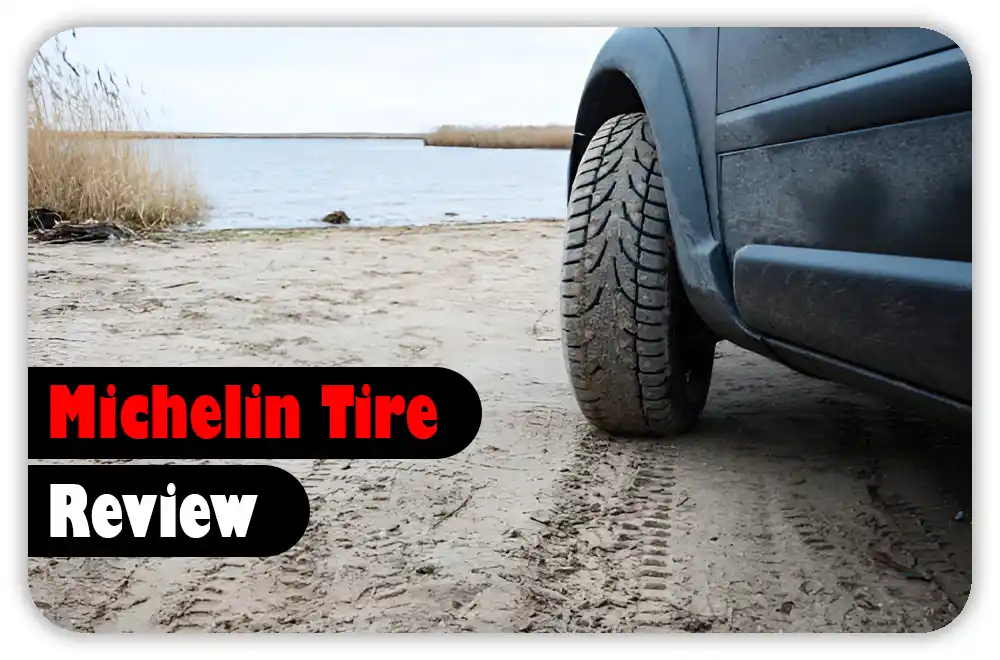
Whether you’re a daily driver or a weekend traveler, Michelin offers a strong mix of comfort, grip, and long life. Here’s how they’ve worked for me in real-world U.S. driving.
Real-World Performance: My Experience with Michelin Tires
Cold Weather & Snow: I’ve spent many winters in Minnesota. That means black ice, deep snow, and cold roads. The Michelin X-Ice Snow gave me great grip. Even on slick roads, I could stop at red lights without sliding through the intersection. That’s peace of mind you can feel.
Long-Distance & Highway Driving: I drove from Chicago to Denver—2,000 miles—with Michelin Defender LTX M/S tires on my SUV. The ride was smooth and quiet, even at 80 MPH. I also got 2 to 3 more MPG than I did with my old Coopers. Michelin’s low rolling resistance is real.
Stop-and-Go Traffic & Urban Driving: Driving in L.A. traffic is rough. You need grip, fast stops, and control in the rain. With Michelin Premier A/S tires, my car felt solid. Even during heavy downpours, I didn’t slide or hydroplane. Stopping felt sharp and safe.
Key Technical Aspects
- Tread & Grip: Michelin uses EverGrip™ tech. The grooves in the tread widen as the tire wears down. That means strong wet grip, even at 30,000 miles in.
- Tread Life: I’ve gotten 60,000 to 80,000 miles from most sets—without being strict on rotations. That saves money over time.
- Comfort & Noise: These are some of the quietest tires I’ve used. Even on rough highways like I-70, the noise stayed low.
- Weather Ratings: Most Michelin all-season and snow tires have the 3PMSF badge. That means they’re built for real snow. UTQG scores are also high, so you get good wear and traction.
What I Like About Michelin
- Strong grip in all weather: Dry, wet, or icy—these tires hold the road.
- Lasts a long time: I’ve seen 70,000 miles on the Defenders with no big drop in performance.
- Smooth and quiet: Way softer than budget brands. Less road noise, more comfort.
- Better fuel use: On highway drives, I saved gas—up to 3 MPG better than other tires.
- Works for many drivers: Great for commuters, long trips, and even light off-road if you go with the LTX line.
What Could Be Better
- Higher price: Michelin costs more than most. But the long life helps even that out.
- Not a full winter tire: In deep snow areas like New York, I still switch to true winter tires.
- Harder to find on sale: Costco is solid, but some models are out of stock at big retailers.
- Can feel stiff: Performance tires like the Pilot Sport can feel rough on small or older cars.
Recommendation: Should You Buy Michelin Tires?
If you drive often and want a tire that you can trust, Michelin is a great choice. They’re built to last, save gas, and keep you safe. That’s why I’ve used them for over 20 years.
Buy Michelin if:
- You live in a place with mixed weather.
- You drive long trips and want peace of mind.
- You care about comfort and quiet roads.
Consider other options if:
- You live where snow gets deep.
- You’re on a tight budget.
- You want hard-core off-road tires.
Final Thoughts
Michelin may not be flashy, but they’re solid. After driving in almost every U.S. state, I trust them with my safety—and that says a lot.
👉🏿👉🏻 Check Latest Price and Offer at Amazon 👈🏻👈🏿
Goodyear vs Michelin: Details Comparison
I’ve driven across the U.S. for more than 20 years. From snowy backroads in Minnesota to long summer drives through Texas, I’ve tested a lot of tires. Two names always come up—Goodyear and Michelin. So, which one is better? Let’s compare based on real road use.
Tread Design & Grip: Goodyear vs Michelin
Both brands have solid grip tech. Goodyear uses deep grooves and angled blocks. Michelin adds more siping and advanced rubber to hold better in all weather.
In snow, Michelin held steady and sharp. Goodyear worked well too, but felt loose on corners. On dry roads, both did fine. Wet roads? Michelin gave me more control.
| Aspect | Goodyear | Michelin |
| Dry Traction | Strong cornering | Better control |
| Wet Performance | Good grip | Excellent |
| Snow/Ice Grip | Decent | Best in class |
| Off-Road Handling | Fair | Not designed |
Rating: Goodyear: 8/10 | Michelin: 9.5/10
Durability & Tread Life: Goodyear vs Michelin
Michelin lasts longer. Simple as that. Goodyear is solid too but wears faster, especially if you don’t rotate often.
My Goodyears wore down at 45k miles. Michelin Defenders? I pushed 70k miles before swapping.
| Factor | Goodyear | Michelin |
| Mileage Warranty | 85,000 max | 90,000 max |
| Treadwear Longevity | Fair | Very high |
| Sidewall Strength | Thick, sturdy | Durable layers |
| All-Season Perf. | Reliable | Excellent |
Rating: Goodyear: 7.5/10 | Michelin: 9/10
Comfort & Noise Levels: Goodyear vs Michelin
Michelin is the quiet champ. Goodyear tires are soft and comfy, but they hum more on rough roads.
On a 10-hour drive, the Michelin tires made less noise. The ride felt smoother, too. Goodyear wasn’t bad, just louder over time.
| Comfort Factor | Goodyear | Michelin |
| Road Noise | Noticeable hum | Very quiet |
| Ride Comfort | Smooth enough | Plush ride |
| City Driving | Grippy | Easy to steer |
| Highway Stability | Stable | Super stable |
Rating: Goodyear: 7/10 | Michelin: 9.5/10
👉🏿👉🏻 Check Latest Price and Offer at Amazon 👈🏻👈🏿
Fuel Efficiency Impact: Goodyear vs Michelin
Both offer fuel-saving tires. But Michelin takes the edge with lower rolling resistance.
Swapped Goodyear Fuel Max with Michelin EnergySaver. I got 2 more MPG.
| Factor | Goodyear | Michelin |
| Rolling Resistance | Low | Ultra-low |
| MPG Improvement | Small boost | Noticeable gain |
| Eco Materials | Some models | Many models |
Rating: Goodyear: 7/10 | Michelin: 9/10
Temperature Performance: Goodyear vs Michelin
Heat or snow? Michelin flexes better. Goodyear gets stiff when it’s super cold.
One icy morning, the Goodyears were rigid. My Michelins stayed soft and steady.
| Condition | Goodyear | Michelin |
| Cold Weather | Okay | Great |
| Hot Weather | Holds up well | Very consistent |
| Seasonal Versatility | Good | Excellent |
Rating: Goodyear: 8/10 | Michelin: 9.5/10
Longevity & Maintenance: Goodyear vs Michelin
Michelins go the distance. Goodyears hold up but need more care. Rotate them often to avoid edge wear.
| Longevity Factor | Goodyear | Michelin |
| Lifespan Expectancy | 55–65k miles | 65–80k miles |
| Rotation Frequency | 6,000 miles | 7,500 miles |
| Puncture Resistance | Decent | Strong layers |
Rating: Goodyear: 7/10 | Michelin: 9/10
👉🏿👉🏻 Check Latest Price and Offer at Amazon 👈🏻👈🏿
Final Recommendation: Goodyear vs Michelin
Buy Goodyear if…
You want good all-season value without the high price. Best for city drivers, daily commutes, or second vehicles.
Buy Michelin if…
You want long-lasting tires that ride smooth and grip in any season. Great for families, road trippers, and those in cold or wet states.
Consider other options if…
You go off-road often. Or if you drive in deep snow a lot—then you’ll need true winter tires like the Blizzak.
FAQs: Goodyear vs Michelin
Which is better for all-season driving: Goodyear or Michelin?
Both are great, but Michelin often feels smoother and lasts longer. Goodyear is strong on value and works well for daily use.
Do Michelin tires last longer than Goodyear tires?
Yes. Michelin uses better rubber that wears slower. Many drivers get more miles before needing new tires.
Are Goodyear tires good for winter roads?
Yes. Models like the Ultra Grip work well in snow and ice. But for harsh winters, a true snow tire is still best.
Which brand offers better fuel efficiency: Goodyear or Michelin?
Michelin often gives better MPG due to low rolling resistance. Goodyear has fuel-saving tires too, but Michelin leads here.
Is Goodyear cheaper than Michelin?
Yes. Goodyear tires usually cost less. Michelin tires are pricier, but they can last longer and save you money over time.

